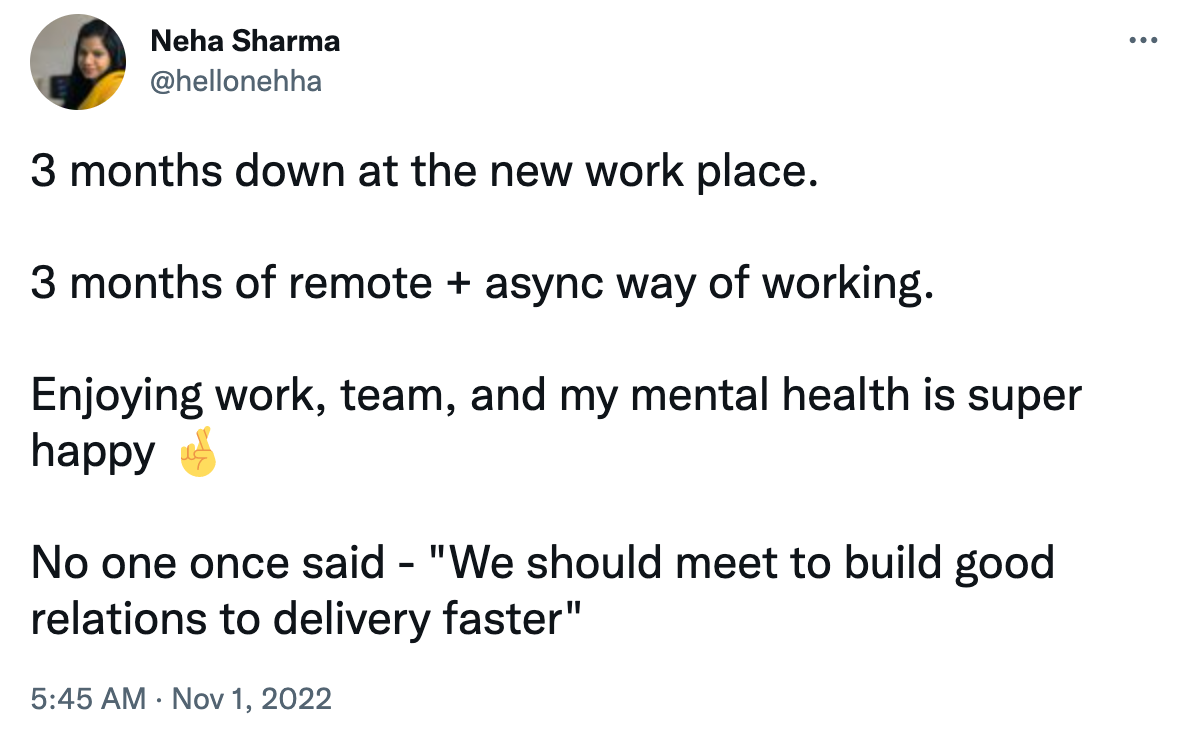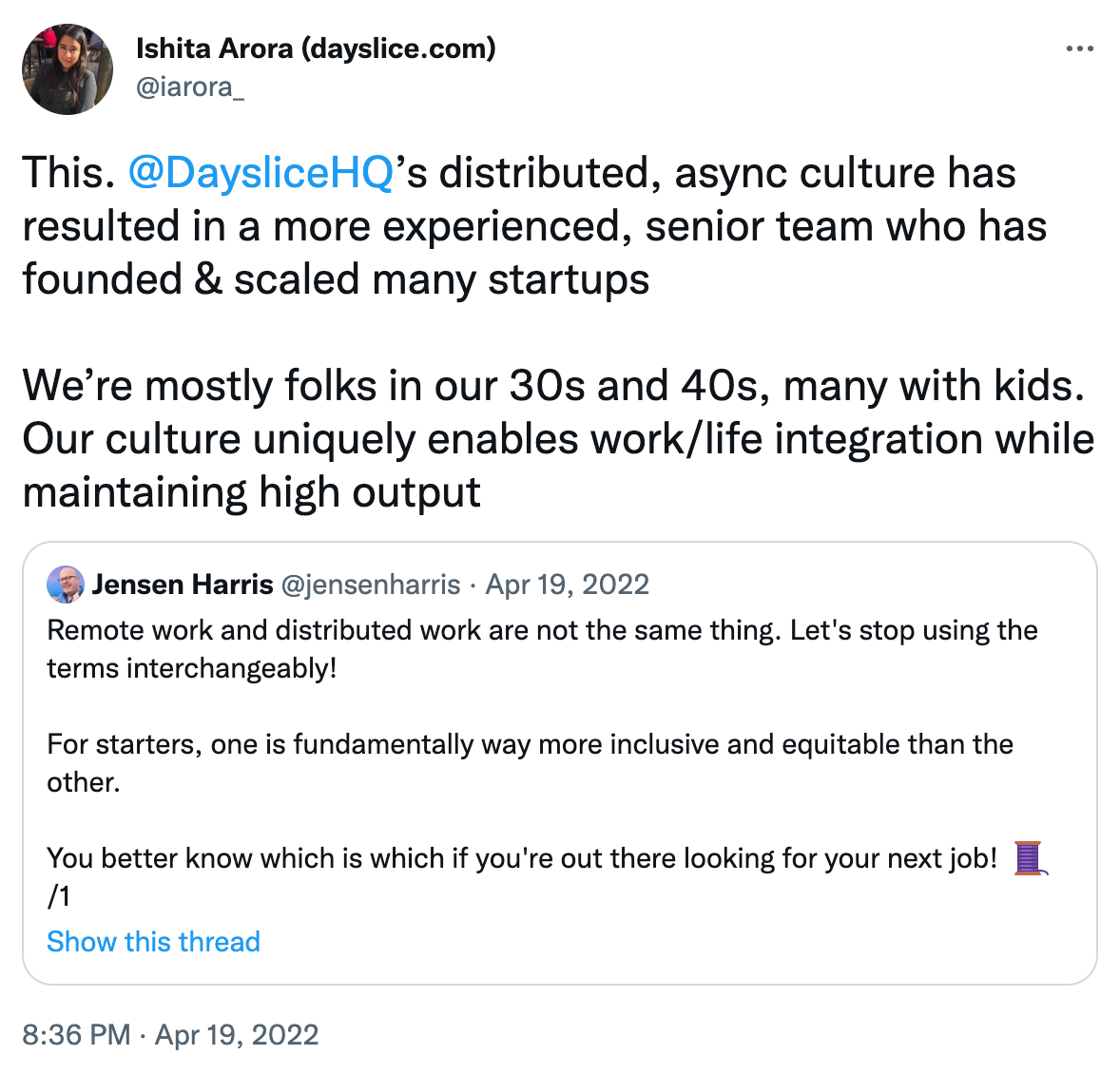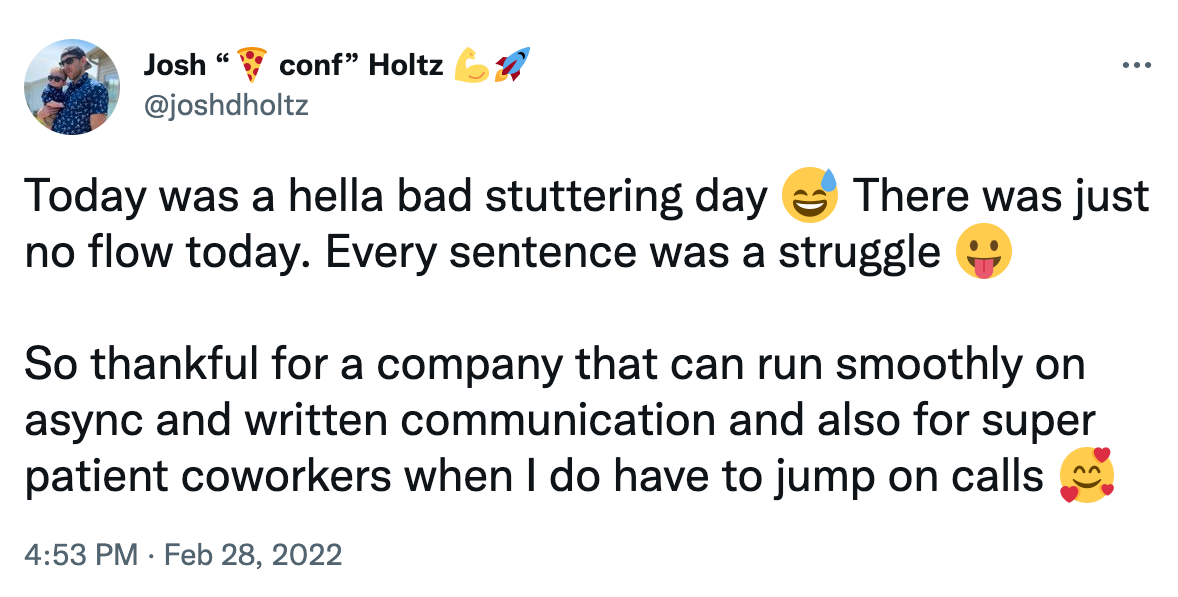Want a more inclusive workplace? Embrace an async-first approach
By Elaine Meyer
In their rush to return to the ways of working they're most comfortable with, they've failed to consider the perspectives and talents their companies have been missing out on.
In today's newsletter, Elaine shares the stories of several workers — including a number of newsletter members! — who've been able to build meaningful careers and create value to their teams because their companies embraced an async-first approach.
Can we make the workplace better for everyone by trusting people to decide where and when they work best? I tend to think the answer is yes. I'll let Elaine take it from here.
Until next time,
Becky and the Twist team
Did someone forward this to you? Learn what this newsletter and community is all about

After taking medical leave from his job to get treatment for bipolar disorder, Bryden Larsen was facing the prospect of not being able to work for the foreseeable future. Almost a year into various treatments, including electroconvulsive therapy, ketamine therapy, and medication, his psychiatrist and therapist recommended he go on permanent disability.
But Larsen, who had most recently worked as a manager of an Apple store in Boise, Idaho, was not ready to walk away from the workforce. His psychiatrist told him that in order to work, he would need a flexible schedule that allowed him to step away when he had to treat his psychiatric symptoms.
“I was so determined to work. Even though I was under review for permanent disability, I felt, this isn't what I want.”
Larsen decided to look for remote jobs, which he believed would be more likely to give him the flexibility he needed to manage his health. After interviews with several companies, he was offered a position this past summer at a distributed San Francisco-based education technology firm, Torch—two weeks before his permanent disability was set to start.

Larsen had been upfront with Torch during the interview process about his health and the need to go to regular doctor’s appointments during work hours. Although he works a customer-facing role, the company is fine with him planning his schedule in advance around mental health visits, as long as he puts in eight hours a day. The ability to communicate asynchronously gives him control over his work hours, making it possible for him to do well at work and take care of his mental health — a balance which once seemed impossible.
“Not only is it great to have that asynchronous environment, where I have the freedom as long as I'm hitting my hours to do what I need to do, but I also have a team and a supervisor who are incredibly supportive,” he says.
Despite Larsen’s strong desire to work, many workplaces would not have accommodated him — or the millions of others whose circumstances make a traditional in-person workday difficult. Today, even as the pandemic showed that people around the world are capable of working remotely, many organizations are pushing for returns to an office.
“If I had been at an office, people would have been like, ‘What is she doing, Why is she never here?’”
At the same time, many remote organizations have created micro-managerial environments full of meetings, Slack check-ins, and even employee monitoring software. At Twitter, Elon Musk’s abrupt elimination of their “work-from-anywhere” policy and his ultimatum of either “at least” 40 hours in the office or “resignation accepted” received a ton of attention. But according to a survey by Resume Builder, a remarkable 90% of companies will require employees to return to the office for at least part of the week in 2023. And many more have created highly synchronous remote work environments where employees have flexibility in location but not schedule.
On a more encouraging note, the pandemic shift to remote work has helped open the workplace to people who haven’t traditionally been accommodated. Adults with disabilities, who make up 13% of the population in the United States, “have rarely been employed in such high numbers," Bloomberg reported in October. And the percentage of disabled people either working or looking for work rose to an historic high of 39% last month, an increase of 6% since April 2020, according to the Kessler Foundation and the University of New Hampshire. That’s a jump of over 2.5 million people who now have the opportunity to make a living.
We spoke to several people who told us how a remote, async-first work environment — free from daily commuting, back-to-back meetings, presenteeism, and “always-on” communication — has made it possible for them to manage health conditions, to be more present as a parent, or simply to produce better work, in ways a traditional work schedule did not.
What’s becoming clear is that traditional, synchronous work environments privilege some over others. If organizations rush to move back to this structure, they run the risk of leaving many people — and the valuable perspectives they bring — out of the workforce entirely.
Parenting: With an async, remote schedule, parents can be home with their kids for dinner, take their children to appointments, and have time to breathe
Krissy, who is married with two young children and lives northwest of Philadelphia, has worked since March as the manager of people and culture at a California-based tech company, where she’s helping to build a team that is distributed across many time zones and countries. Her flexible schedule has given her more quality time with her family, a benefit that she never would have enjoyed at previous in-person roles.
Krissy discovered the possibilities of async work when her previous job — working in human resources at a manufacturing company — went remote in March of 2020. That October, she had her first child. Working remotely — especially after years working in retail — was a revelation:
“I was so new to my company, so it was very strange to jump directly to a remote setting, but I fell in love with it. I could roll out of bed in the morning and sit down to focus for an hour before grabbing breakfast. I could run out for one of the many obstetrician appointments that come along with having a kid and not feel guilty,” she says.

In 2021, her employer started bringing workers back into the office a couple days a week, with the plan to eventually go back full-time. On the days she went in, Krissy got home at 6:30 p.m., with only 30 minutes to spend with her daughter before bedtime.
“We ate takeout on those days, and I was just exhausted and felt like I accomplished nothing,” she says.
She knew that she didn’t want this stressful lifestyle to be the norm anymore, especially because she was expecting another child. Fortunately, a recruiter contacted her about her current, flexible role.
I have been working in healthcare data & analytics field with the passion to bring cross-functional, remote, diverse team to make great things…To me, async means flexibility and it means a ton to me as I just became a mom… I think twice before I send an invite and encourage my team to do so as well.
Quinn C., Async Newsletter member
Now, she’s able to log off at 5 p.m. every day, just as her husband is arriving home from picking up their kids at daycare. She can make dinner every night, eat with her family, and not experience the “mom guilt” she battled when she had to go into work. During the workday, she can take her kids to appointments when needed, because she’s not expected to respond to messages right away. If something is truly urgent, her team knows they can call her.
“Last week, my son had an appointment on Monday, I had an appointment Tuesday, my daughter had an appointment Wednesday, and my son had one Thursday. On these days I can start earlier or work later. As long as I get my work done and things are moving forward, I’m good,” she says. “But if I had been at an office, people would have been like, ‘What is she doing, Why is she never here?’”
So far, her company has been very happy with her work, she says.
As a parent, Krissy is far from alone in her desire for a more async workplace. Eighty-two percent of women want workplace flexibility, according to a survey by Future Forum. But the struggle to find consistent, quality childcare means that parents are more likely to leave their jobs than non-parents, according to a survey by McKinsey. Lack of employer flexibility for parenting and other caretaking has serious implications for workplace diversity: the U.S. currently has the lowest rate of workforce participation by women in the last 33 years, according to HR Daily.
A flexible work schedule is a godsend for Krissy and her husband, who both have parents living over an hour away. Isolated by necessity during the pandemic, they’re just now starting to meet other parents at daycare.
“Not everyone has that extended community. Not everyone has their village,” Krissy says.
Neurodivergence: With async work, people with ADHD, autism, or others who are neurodivergent, can embrace their natural work style
Modern office work is filled with frequent interruptions, back-to-back meetings, and sitting in front of a computer at a desk for hours on end. But many people don’t work well this way. People who are neurodivergent, like those with autism, attention hyperactivity disorder (ADHD), or dyslexia, often report finding traditional office culture over-stimulating and challenging for focusing on deep or creative work.
"Because of the ways ADHD impacts executive function, the mental burden of preparing for and then recovering from a meeting often takes longer than the meeting itself."
When a new manager at her office job started holding more in-person meetings, Brittany Berger, an LA-based content marketing strategist and founder of WorkBrighter.co, who has diagnosed ADHD and autism, started to notice an effect on her work. The meetings really threw off her day, and she only had one or two hours for creative work.
“Before working with companies that embraced flexibility, that often meant struggling to get things done all day at the office, then coming home and getting my ‘real productivity’ done at night, which meant I was working around the clock,” she says. “Because of the ways ADHD impacts executive function, the mental burden of preparing for and then recovering from a meeting often takes longer than the meeting itself.”

An async schedule is an important way to hire and retain neurodivergent people. As JD Alex, a talent researcher for Stripe, told Remote:
“Giving a person the space and time to decide when they are most productive and feel their best is the best thing companies can do for their neurodivergent team members. We cannot expect our team members to come to work and perform at 100% if we are telling them that their 100% has to be between 9-5.”
The beauty of ADHD is that my brain is already wired to think differently. Post-diagnosis, I've realized this has been a consistent quality that's made me a high value and sought-after team member.
The issue, however, is that how that innovative thinking happens often clashes with the general idea of "productivity," and sense of a "workday" especially in a Governmental type of environment.
I have a somewhat self-guided workload and with that work more around when my brain is in "flow" vs. forcing myself to do the things (especially things I don't believe is necessary or beneficial to business) throughout the workday for productivity's sake.
– Jess G., Async Newsletter member
Health: For those with health conditions, async work can be the difference between staying employed, or not having a job
Though he has mostly felt good since he started his job at Torch, Larsen has had a few depressive episodes and anxiety attacks. In previous jobs, this would have meant staying home, but his supervisor at Torch has supported him shifting from customer-facing work and to more admin on difficult days.
“Instead of the team having to pick up 100% of my workload, they may only be picking up 30 to 40% of that workload,” Larsen says. “And in return, when I’m feeling better, I try and do the same for the rest of my team. In a traditional environment, they would've said, ‘You're going to do 100% or zero, and that's it.’”
If async work isn’t available for people with health conditions, it can cut them out of the job market entirely. As Async Newsletter member Nanci shared, “It's been a little over 5 years since I left my job as a Safety and Health Coordinator at a major corporation due to medical issues. I loved my job, but it was constant meetings, so I was always looking for some way to be more productive. When I started having medical problems, I begged HR to let me work from home. Their response was that they couldn't allow it, because then everyone would want to work from home. So I went on disability and eventually left the company.”
"We cannot expect our team members to come to work and perform at 100% if we are telling them that their 100% has to be between 9-5.”
Emily Bhattacharya, a senior accounts manager at Float, wrote in the company’s blog that being able to work remotely made it possible to not only manage her Crohn’s disease and Ankylosing spondylitis, but thrive in ways she hadn’t imagined. When she used to work in an office, she didn’t eat from 6 a.m. to 6 p.m. to avoid having an accident at work. She also “needed a minimum of 10 hours of sleep or more each night and a fistful of medications just to survive the day.” Her remote job shaved two hours of commuting off her day and allowed her to move to Northern Italy, where she grows her own produce, takes daily walks, and has been able to cut back significantly on her medications.
As she puts it: “Flexible work hours make attending maintenance and ongoing treatment appointments easier and remove[s] any fear of disappointing your employer. When an employer allows its employees to work from their own safe and accessible environment, it removes a lot of stress and leads to a better work-life balance.”
It’s important to note that flexible work benefits all kinds of workers — not just parents, or the neurodivergent, or people with health issues. In thoughtful async arrangements, everyone has more time for a well-rounded, healthy, and fuller life. Plus, if people are given more space to take care of themselves over the course of their day, they’ll be in a better place to do a good job at work — which is good for the organization.
As journalist Charlie Warzel has said, “It’s remarkable how people perform when their needs are being attended to a little bit better.”
The async approach honours the need that people have to manage their own work in their own time, without constant pestering from us or anyone else to meet an assignment deadline. I've worked from home for most of the last 20 years and have loved working with those who honour the idea that, if I don't contact them instantly, it's because it's not the right/best/appropriate time for me to do so.
- David, Async Newsletter member
Mandating that everyone work in the same place on the same schedule not only creates an organization that is less diverse, it lowers the morale of the people who work there — which is bad for everyone. Flexible work should be reframed from an accommodation that is provided at a loss to the organization, to a significant contribution toward building a more diverse, inclusive, and successful work environment.
3 things worth sharing
- I'm Black. Remote Work Has Been Great for My Mental Health. "Looking back on those jobs, I wonder: How many racist scenarios, comments, and situations would I have avoided enduring if I didn’t need to come into the office?"
- You Are Mommy Tracked to the Billionth Degree. When hybrid companies let employees work from home without changing the way they work, women end up getting the short end of the stick.
- Why Diversity Programs Fail. And what works better.
What’s Twist? Twist is an async messaging app for teams burned out by Slack chats, meetings, and email.
You don’t need to use Twist to get a ton of value out of this newsletter and community. But if the topics we talk about resonate with you, there’s a good chance the app will too. See what makes Twist different →
🌎 Built async-first by the fully remote team at Doist
